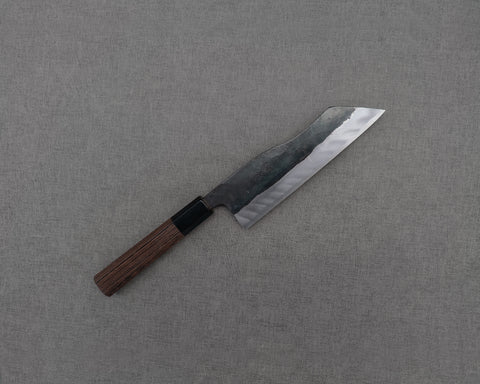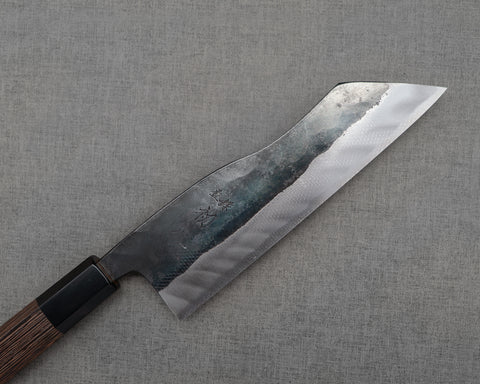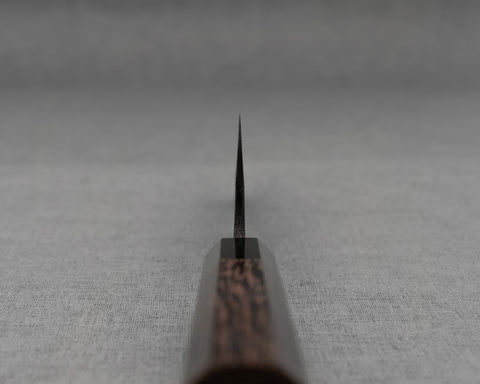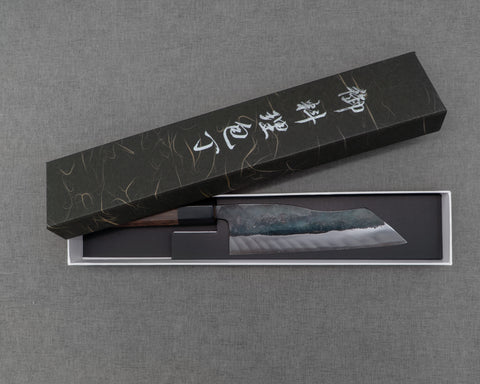Hatsukokoro






Hatsukokoro "Kuronami" Aogami #2 Kurouchi 165mm Hakata
目前沒有提供取貨服務
Hatsukokoro has been consistently improving their entry level Aogami #2 collection, and they have reached a new milestone with their "Kuronami" (Black Wave) series. Hakata knife is a variation of the popular bunka knife - sharing the k-tip but with a distinct curve to its spine. This knife shape was originated from the Hakata region in Fukuoka Prefecture, hence the name. For a knife forged in Toza, this knife has more refined grind than the typical Toza productions, while keeping the rustic blacksmith kurouchi finish that kept the cost low. The standout feature is the ripple kasumi finish near the blade edge, a fun addition to the look.
Spec:
- Origin (Made in): Tosa, Kōchi Prefecture, Japan
- Brand: Hatsukokoro
- Knife Type: Hakata
- Blade
- Construction: Sanmai
- Grind: Double-edged Blade (50/50 Grind)
- Hagane (Core Steel): Aogami #2 (Blue #2)
- Jigane (Cladding): Soft Iron
- Hardness: 62-63 HRC
- Hand-forged, hand-ground, hand-sharpened
- Blade Finishes:
- Kurouchi
- Kasumi
- Blade Length (heel-to-tip): 165mm (6.5")
Blade Height (at heel): 46mm - Spine Thickness
- Above heel: 4.2mm
- Middle: 2.0mm
- Handle
- Shape: Hachikaku (Octagonal)
- Material: Wenge
- Kuchiwa / Tsukajiri: Black Buffalo Horn
- Length: 128mm
- Overall Length: 312mm
- Weight: 150g (5.29oz)
- Stamped Mark (Front): In Japanese Kanji "Trademark Hatsukokoro" (登録 初心)
- Stamped Mark (Back): In Japanese Kanji "Aogami" (青入)
Care:
Aogami #2 (Blue #2) steel is a premium Japanese high carbon steel for knife making. It is not stainless, therefore you must wipe your knife dry after each use, in particular the core steel not covered by the stainless cladding. Patina will develop over time, which will appear as “discoloration” on the cutting edge, but that is the nature of carbon steel - not a defect. The stainless cladding covers a large part of the blade, making maintenance easier but still preserving the cutting and sharpening pleasure of the Aogami Super core. Avoid cutting into bones, frozen foods, hard fruit pits.
Cutting Surface:
Recommended cutting surface: wood, rubberized boards and high-end composites, and quality plastics such as polyethene make acceptable cutting surfaces, and will help protect and prolong knife’s edge. AVOID glass, metal, countertops, and other rigid, non-forgiving surfaces.
Sharpening:
We recommend sharpening all quality Japanese knives on whetstones, as we believe they yield the best results for your knives.
Fast shipping, well packed. Incredible knife.
